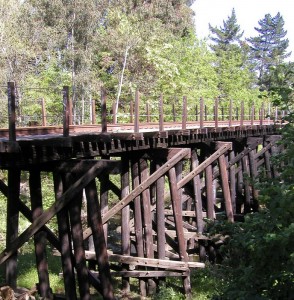Learn about the Three Creeks Trail train trestle on a video
A community campaign to save a 91-year-old train trestle from demolition is picking up steam, even though the San Jose City Council has voted twice to replace it with a modern steel bridge for pedestrians and cyclists along Three Creeks Trail.
Willow Glen trails advocate Larry Ames and a growing group of trestle supporters want the council to reconsider their unanimous votes to demolish the trestle and vote instead to restore it. Or, at the very least, give the issue a broader public hearing.
Restoring the trestle was in the original plan when the city, county and water district pitched in money to buy the former railroad corridor to ensure that it would be used for a critical segment of the Three Creeks Trail to connect to the Los Gatos Creek Trail. The trestle is the only way to connect the two trails. Eventually, it will also link to the Guadalupe River and Coyote Creek regional trails.
“I’m encouraged,” Ames said. “I’m really appreciative of community support and enthusiasm. “
Support could be growing among elected officials, too.
On Tuesday, May 14, the Santa Clara County Board of Supervisors voted unanimously approved a memo by Supervisor Dave Cortese asking the county parks staff to work with the city to exploring ways to save the trestle.
“The County, as a partner in this trail, may have resources available that could supplement the City’s evaluation of this potential historic landmark,” he stated in the memo. “As we move forward, it makes sense to evaluate this opportunity and assess the impact of losing these structures.
But it’s uncertain if the city council will take any action to re-consider the votes. On May 15, the council’s agenda-setting committee rejected Councilman Pierluigi Oliverio’s suggestion to schedule a study session to determine if more analysis is needed on the trestle’s condition by another engineering firm. Oliverio was a strong proponent of replacing the trestle during discussion before the votes on March 26 and April 9.
But since then, trestle supporters have pointed out what they believe to be flaws in the engineering study that recommended a steel bridge but also stated that restoring the trestle was possible. The supporters question the study’s estimated cost of demolishing the bridge as too low and restoring it as too high.
“We are pleased the city is moving forward on the Los Gatos and Three Creeks Trails,” wrote Larry Ames and Helen Chapman in a San Jose Mercury News op-ed piece. “But before committing to spend millions of dollars needlessly, the city needs to put demolition on hold, collect all the facts and thoroughly evaluate options.”
“I want to find out what it really costs to demolish the trestle,” Ames said in an interview. “I’m sure it’s more than $58,000.”The questions caught Oliverio’s attention.
“The council should consider a second opinion if a validated scenario exists to preserve the existing structure at a lower cost than previously detailed,” he wrote in a memo to the Rules Committee. “The outcome would be a seismically safe structure with no potential liability for the city.”
A Mercury News editorial has also urged the council to give the trestle restoration option another look.
When the city council voted on March 26 to recommend replacing the trestle, there were only a few public speakers on the item, all from Save Our Trails, a countywide organization that promotes trail building, SOT’s board had voted to support the recommendation to replace the trestle.
“It was only after lengthy deliberation, and careful consideration of the arguments for preserving the structure, that the Board determined that the best course of action would be to replace it,” SOT secretary Martin Delson wrote in a letter to the mayor and council. “One important consideration for us was the anticipated high cost of maintenance of a restored wooden structure; maintenance costs that we recognize would come from a budget that has to be shared among the 100 miles of the city’s planned network of trails.”
There was also concern expressed over losing a restored trestle to fire. The bridge has been damaged by fires set by people camped by the creek. But it Ames’ words, the wooden trestle is no more or a risk to fire than a telephone pole and more use of the trail will discourage vandalism.
Whatever the final decision, supporters think there should be more public input.
“We’re just asking don’t come to the first meeting and say it’s a done deal,” Ames said.
